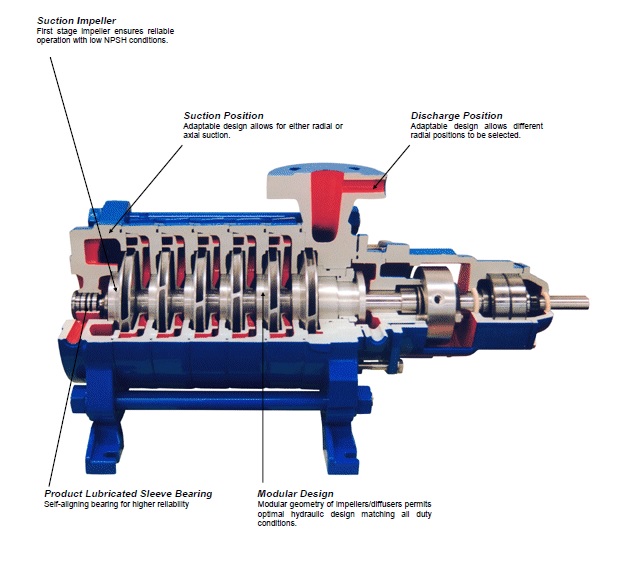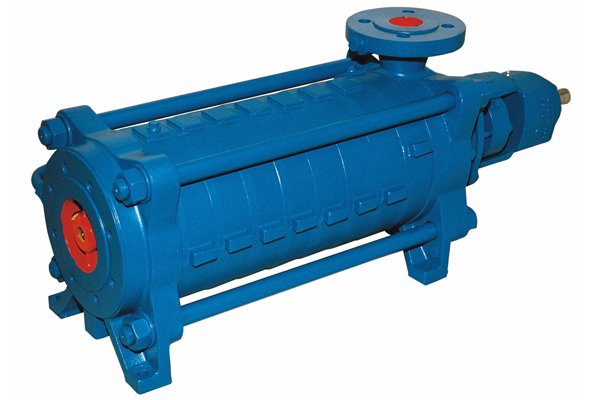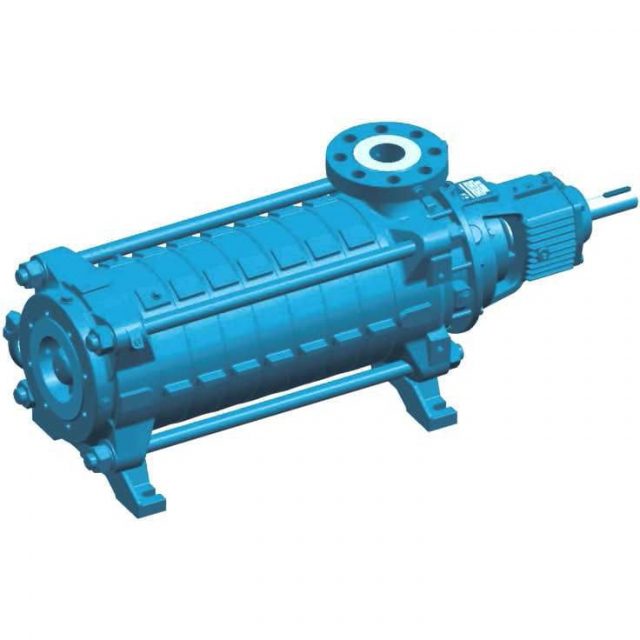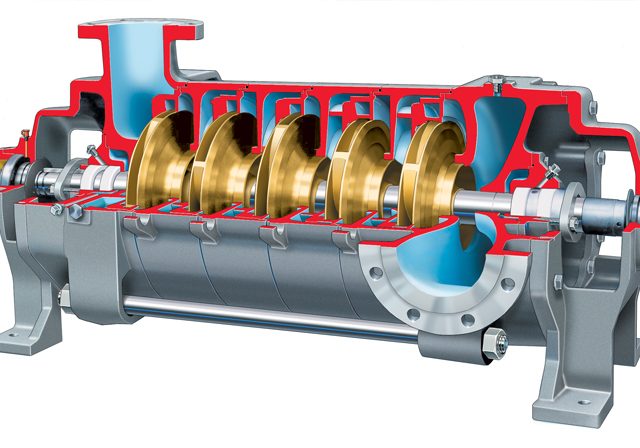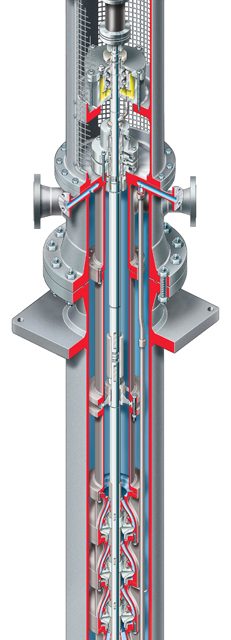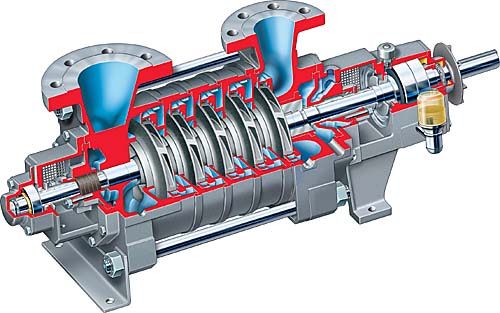Multistage Pump
A multistage pump is a type of pump which contains 2 or more impellers which may be of the same or different types i.e low NPSH suction impeller, double suction impeller or combination with Centrifugal first stage and side channel stage impellers.
What are the multi stage pump parts?
The multistage pump parts are very similar to those of the standard Centrifugal pump except for the Multistage Centrifugal pump where the additional parts are diffusers which efficiently channel the fluid into the eye of the impeller or to the following stage. In the side channel pump, there are intermediate plates with the scalloped side channel and liquid parts.
In multistage centrifugal pumps, because of the high thrust that is generated due to the impellers facing in the same direction, there will be a thrust balance device i.e balance disc or balance drum which reduces the thrust to a level which can be managed by a standard sized thrust bearing.
How does a multi stage pump work?
A multistage pump operates by one impeller feeding into the next impeller and the number of impellers required depend on the discharge pressure requirement. Liquid enters the pump and then passes through the various number of impellers in a sequence from the left to right.
What are the applications and uses for multi stage pumps?
The applications for multi stage pumps are many and varied and can be used for delivering water to high rise buildings, reverse osmosis (RO), boiler feed water, spraying, high pressure cleaning, water works, heating, condensate, fuel delivery, oil and gas production, power generation & mining and other high pressure and temperature applications..
What are the different types of multi stage pumps?
Types of multistage pumps include;
- Horizontal Multistage Centrifugal pump (above ground)
- Vertical Multistage Centrifugal pump (above ground)
- Submersible/Sump pump types
- Side Channel pump
- Combination pumps i.e Centrifugal low NPSH first stage with side channel additional stage.
- Horizontal split case pump
- Vertical Turbine pump
- Sanitary Multistage pump
What are the advantages of using a multi stage pump?
If we were to compare the Centrifugal multi stage pump to a high pressure duty pump – the Centrifugal multi stage pump even though it is more complex and costly, it would probably be a better hydraulic fit, have a better efficiency and be more reliable. With its hydraulic modules, the ability to supply additional impellers and its ability to trim those impellers, the duty point can me met exactly without compromise. The selection is more likely to be close to ‘BEP’ and will run efficiently and reliably.
Multi stage pumps can be configured to have an interstage bleed off if there are multiple duty points required. It may be possible to run a multistage pump at a lower speed than a single stage centrifugal pump which may offer an efficiency advantage but it will certainly run much quieter which is an important consideration in today’s world. A 3 dBA increase represents a doubling of sound as the sound scale is logarithmic.
What is difference between a single stage and a multi stage pump?
A single stage pump uses one impeller whereas a multi stage pump uses 2 or more impellers (some manufacturers use 80 or more impellers).
There are additional components in a multi stage pump which are required for channelling the fluid from the first stage to the following stage i.e diffusers.
Multi stage pumps have a thrust balance device and there may also be intermediate bearings (lubricated by the pumpage) to steady the shaft plus other minor differences.
How do you read a multistage pump curve?
You read a multi stage pump curve in exactly the same way as you read any other pump type curve however some manufacturers will publish single stage curves which means that this has to be multiplied out to establish the number of stages required, however be aware that the side channel pumps have their maximum power at zero flow and the power decreases with increasing flow which is the reverse of a centrifugal pump.
What is the difference between a vertical multistage pump and a horizontal multistage pump?
The main differences between a vertical multi stage pump and a horizontal multi stage pump are;
- the orientation of the pump
- the vertical multi stage pump is above ground and may be used where there are space limitations however the motor needs to be removed before maintenance can be performed.
- vertical multi stage pumps are used in some applications where the motor needs to be lifted from the sump so that the unit can be maintained. It is common in vertical pumps for the thrust load to be taken by the motor e.g. VTP turbine pumps which have electric motors specifically designed for this type of pump to eliminate the need for a thrust bearing in the pump resulting in less complexity and costs. VTP pumps can be produced with column lengths of more than 100 metres.
- horizontal multi stage pumps are mounted using feet which for high temperature applications are a special design to allow for thermal growth and thus avoid operating issues due to expansion and contraction. They would need to be aligned with the electric motor. On vertical pumps, the mounting is perhaps simpler i.e for sump pumps, a support plate would be fixed with standard bolting and generally no alignment is required as the motor is flanged and it is self aligning with the corresponding register.
Which type of multistage pump is more commonly used in industry?
In Ireland, the most common type of multi stage pump used in Industry is the horizontal multi stage pump and vertical multi stage pump (above ground) mounted centrifugal pumps. However, multi stage side channel pumps would also be relatively common along with the vertical turbine pumps.
Flexachem offer a full range of Flowserve’s Multi stage pumps.
We provide localised technical support & on-site service engineering to support your operational needs throughout Ireland.
Want to discuss a particular application in more detail? Why not call one of our Pump Specialist team.
Contact our Pump Specialist Team:
Phil Soltan (External) – mob: 086 185 3782
Internal Team
Adrian McSweeney – tel: 021 461 7212
Paul-Fox Morris – tel: 021 461 7231
Una Long (Pump & Service Support) – tel: 021 431 7200
Tel: 021 4617 200

